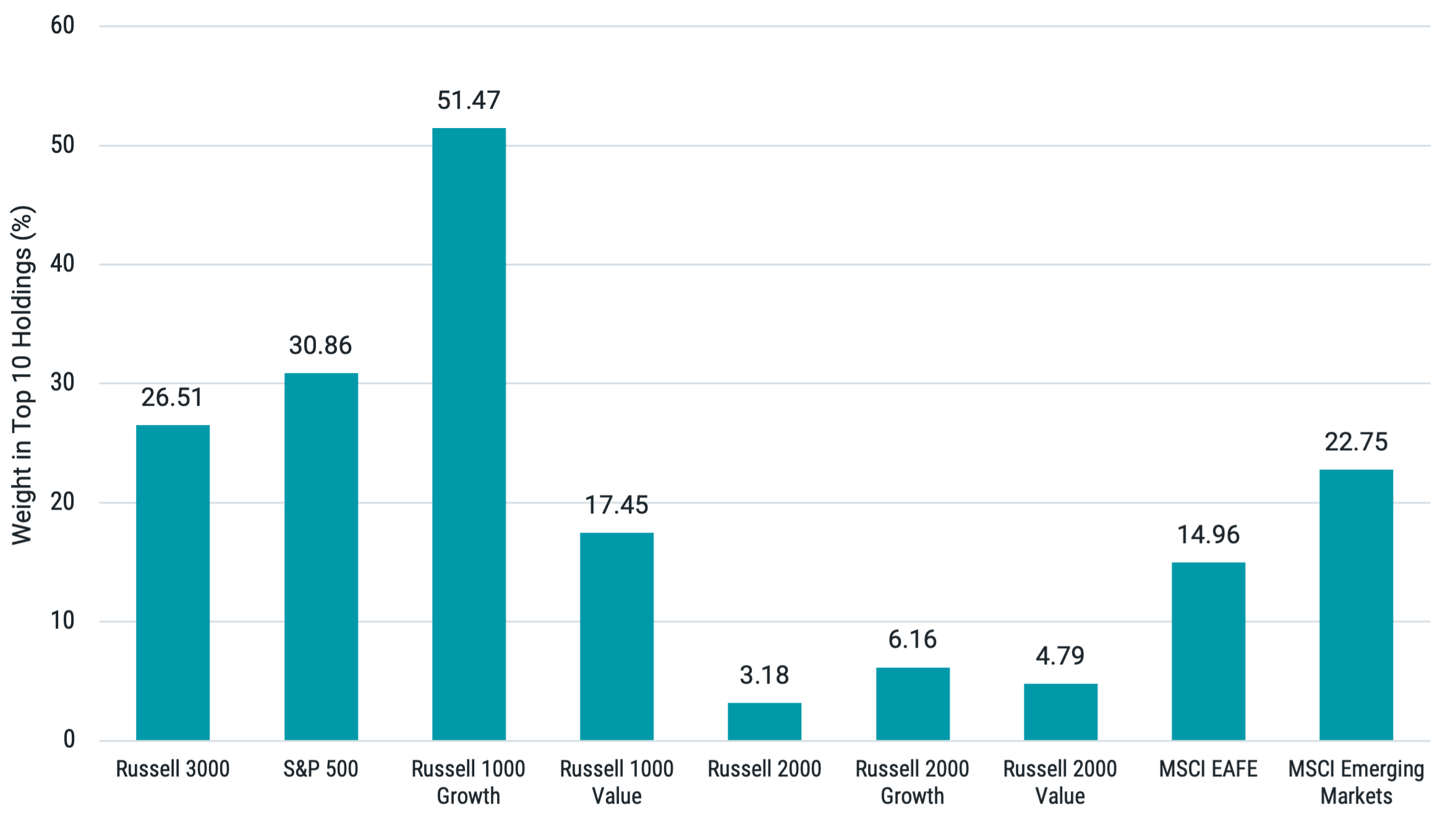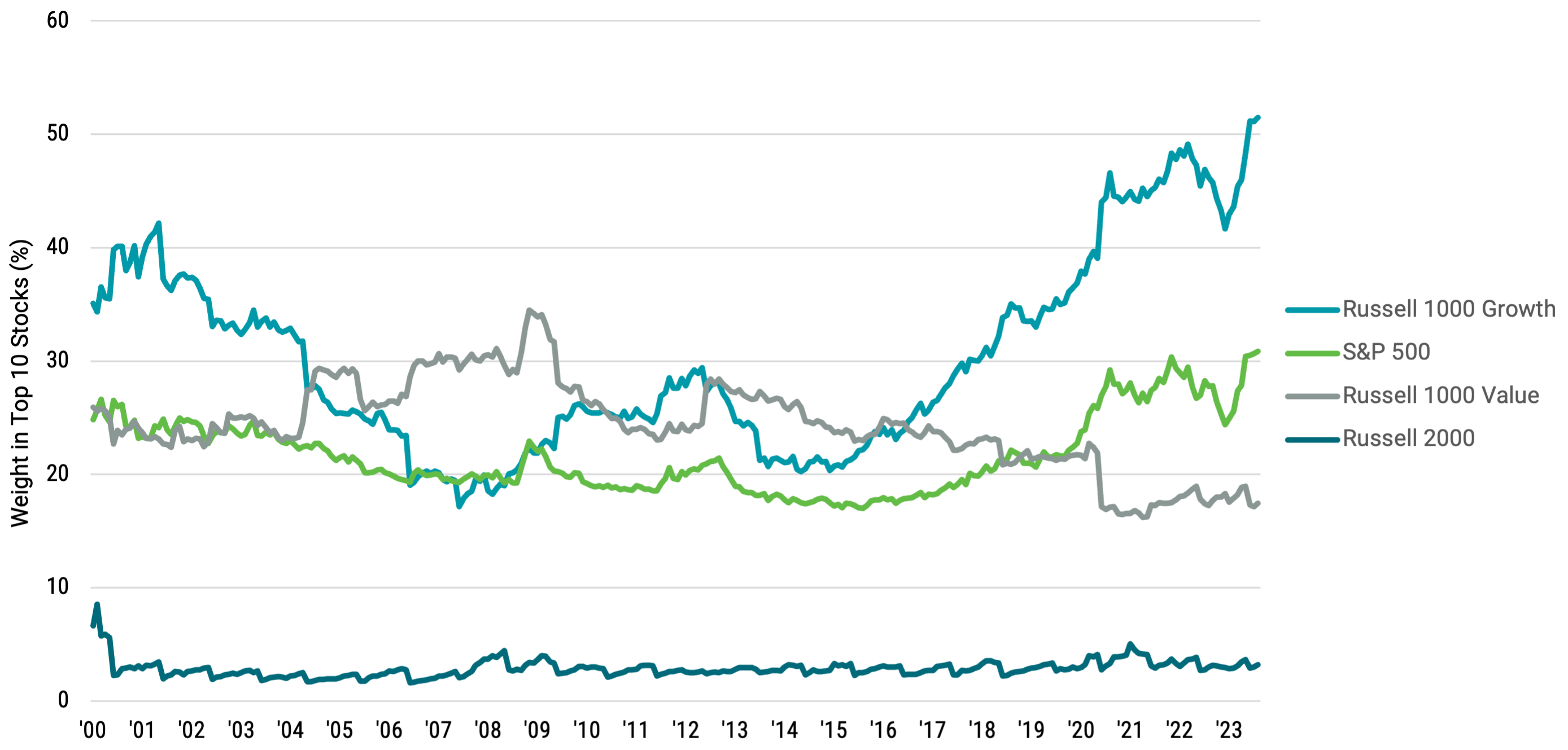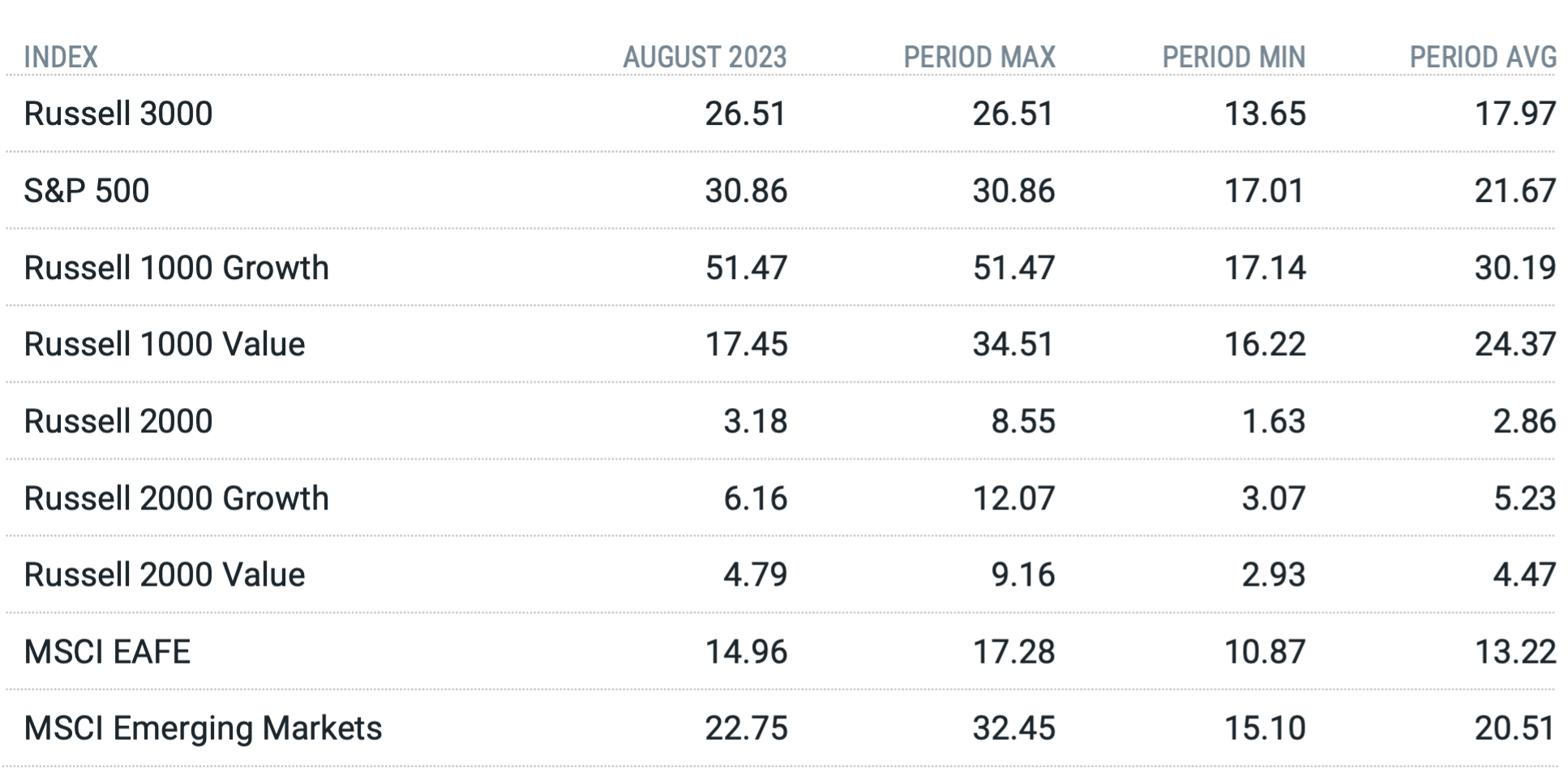Index Concentration: Have Some Indexes Become Too Top-Heavy?
Market indexes designed to represent total stock markets or broad subsets of a market are generally known to offer investors high levels of diversification. Many well-known indices, like the S&P 500® Index and Russell 3000® Index, hold hundreds or thousands of companies. Yet, by some measures, many major indexes appear more concentrated today than ever.
Figure 1 presents the weight of the top 10 stocks in several commonly followed indexes representing U.S. and non-U.S. stock markets. For the U.S., asset class indexes representing market subsets like value and growth stocks are also shown.
Based on the top 10 holdings, the concentration level is most significant among U.S. large-cap stocks, particularly U.S. large-cap growth stocks. The Russell 3000, which contains U.S. large- and small-cap stocks, has more than 26% in its top 10 holdings, while the S&P 500, which includes roughly the largest 500 U.S. companies, has nearly 31%.
But the result that stands out the most comes from the Russell 1000® Growth Index, which represents U.S. large-cap growth stocks. This index holds a whopping 51.5% in only 10 companies! This starkly contrasts with only 17.4% in the top 10 names of the Russell 1000® Value Index, representing U.S. large-cap value stocks.
Figure 1 | Index Concentration is Greatest Today Among U.S. Large Caps

Data as of 8/31/2023. Source: Morningstar.
Figure 2 highlights how top 10 holdings weight has evolved for these U.S. large-cap indexes. We include U.S. small-caps (Russell 2000® Index) for reference. While top 10 stock concentration has historically been higher among large-caps than small-caps, it’s clear that top 10 weight has increased meaningfully over time for the S&P 500 and Russell 1000 Growth, standing today at their highest levels since the start of the century. Russell 1000 Value is near its lowest observed level.
Figure 2 | U.S. Large Cap and Large Growth Index Concentration Has Been on the Rise

Data from 1/31/2000 – 8/31/2023. Source: Morningstar.
Figure 3 provides historical context for each index from Figure 1, showing the current top 10 weight versus its averages since January 2000, along with the maximum and minimum levels over the period. While indexes holding U.S. large growth stocks (Russell 3000, S&P 500, Russell 1000 Growth) are currently at their historical highs, all other indexes are near or below their historical averages and well below their historical highs.
We believe the implications of these observations for diversification and risk are clear. As a small subset of companies make up a greater portion of a portfolio, these companies’ returns will have a greater impact on overall portfolio results — whether good or bad. Further, stocks that run up in price to increase in size often come with higher valuations (the price of a stock relative to fundamentals like its earnings or book value), which may mean holding greater weight in stocks with lower expected returns going forward.
Sound familiar? This has been a widely talked about story in 2023 as many large U.S. companies (primarily growth stocks) have only gotten larger on solid performance but, in many cases, without commensurate increases in their earnings or book values.
Equal-weighted indexes are one approach that attempts to address concerns over indexes becoming too top-heavy or concentrated in companies with high valuations. These indexes take all companies in the market or a subset of the market and hold them at the exact same weight rather than based on market capitalization (a company’s price times its number of shares outstanding) as most well-known market indexes.
What do you get when equally weighting all companies in the market? Versus a market-cap-weighted approach, the result is less weight in large companies and more weight in smaller firms. In other words, this produces a tilt toward companies with small and mid-sized market capitalizations and away from the largest companies.
Figure 3 | Indexes Holding U.S. Large Growth Stocks Are Currently at Concentration Level Highs While Other Indexes Are Near or Below Avg.

Data from 1/1/2000 – 8/31/2023. Source: Morningstar.
This approach also tends to tilt toward companies with lower prices to fundamentals, commonly known as value companies. But treating all companies the same, ignoring prices and fundamentals, isn’t likely the best way to achieve these tilts and address concerns with the current market concentration “problem.” Under this approach, a tiny micro-cap company with negative earnings and a weak balance sheet would receive the same weight as the largest company in the market.
Ignoring prices is never a good idea when buying anything. The same applies to investments. Considering company prices is essential since they are the best and fastest way to incorporate news in a portfolio. For example, bad news for a company will push down its price, but an equally weighted portfolio will completely ignore this information.
But considering only prices and ignoring fundamentals, as market-cap-weighted approaches do, also has limitations. The result can be holding more weight in companies whose prices have risen due to overly optimistic earnings growth expectations.
These approaches represent two extremes that can be improved upon using prices and fundamentals when considering how to weight companies in a portfolio. A security’s expected return depends on its price relative to its balance sheet and expected earnings, so including this information when deciding how to weight securities is expected to improve outcomes.
In our view, the takeaway from the data shown isn’t that the market becomes a bad investment because of a subset of large companies becoming a larger portion of the overall market. Naïve approaches that claim to offer a better alternative by deviating wildly from the market may warrant scrutiny and probably some healthy skepticism.
We believe well-constructed portfolios should be designed to balance expected returns and risk carefully, considering companies' prices and financials while targeting broad diversification across companies, sectors and markets. Maintaining a clear understanding of any deviations from the market and the expected benefits and risks of doing so is critically important.
Glossary
Expected Returns: Valuation theory shows that the expected return of a stock is a function of its current price, its book equity (assets minus liabilities) and expected future profits, and that the expected return of a bond is a function of its current yield and its expected capital appreciation (depreciation). We use information in current market prices and company financials to identify differences in expected returns among securities, seeking to overweight securities with higher expected returns based on this current market information. Actual returns may be different than expected returns, and there is no guarantee that the strategy will be successful.
Fundamentals: Investment "fundamentals," in the context of investment analysis, are typically those factors used in determining value that are more economic (growth, interest rates, inflation, employment) and/or financial (income, expenses, assets, credit quality) in nature, as opposed to "technicals," which are based more on market price (into which fundamental factors are considered to have been "priced in"), trend, and volume factors (such as supply and demand), and momentum. Technical factors can often override fundamentals in near-term investor and market behavior, but, in theory, investments with strong fundamental supports should maintain their value and perform relatively well over long time periods.
MSCI EAFE Index: Designed to measure developed market equity performance, excluding the U.S. and Canada.
MSCI Emerging Markets Index: A free float-adjusted market capitalization index that is designed to measure equity market performance of emerging markets.
Russell 1000® Growth Index: Measures the performance of those Russell 1000 Index companies (the 1,000 largest publicly traded U.S. companies, based on total market capitalization) with higher price-to-book ratios and higher forecasted growth values.
Russell 1000® Value Index: Measures the performance of those Russell 1000 Index companies (the 1,000 largest publicly traded U.S. companies, based on total market capitalization) with lower price-to-book ratios and lower forecasted growth values.
Russell 2000® Growth Index: Measures the performance of those Russell 2000 Index companies (the 2,000 smallest of the 3,000 largest publicly traded U.S. companies, based on total market capitalization) with higher price-to-book ratios and higher forecasted growth values.
Russell 2000® Index: Measures the performance of the 2,000 smallest companies among the 3,000 largest publicly traded U.S. companies, based on total market capitalization.
Russell 2000® Value Index: Measures the performance of those Russell 2000 Index companies (the 2,000 smallest of the 3,000 largest publicly traded U.S. companies, based on total market capitalization) with lower price-to-book ratios and lower forecasted growth values.
Russell 3000® Index: Measures the performance of the largest 3,000 U.S. companies representing approximately 98% of the investable U.S. equity market.
S&P 500® Index: A market-capitalization-weighted index of the 500 largest U.S. publicly traded companies. The index is widely regarded as the best gauge of large-cap U.S. equities.
Diversification does not assure a profit, nor does it protect against loss of principal.
It is not possible to invest directly in an index.
Investment return and principal value of security investments will fluctuate. The value at the time of redemption may be more or less than the original cost. Past performance is no guarantee of future results.
This material has been prepared for educational purposes only. It is not intended to provide, and should not be relied upon for, investment, accounting, legal or tax advice.